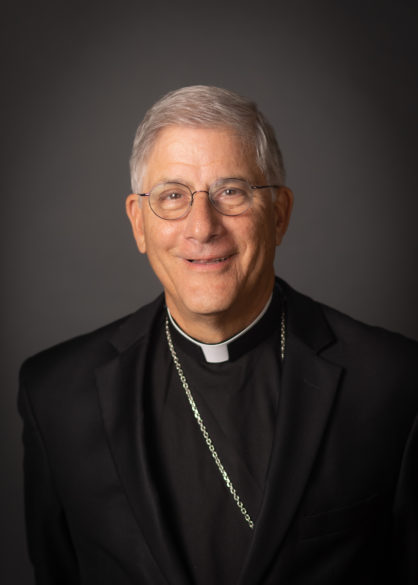Por Obispo Joseph R. Kopacz, D.D.
La Pasión del Señor Jesús se desarrolla ante nosotros durante la próxima semana, comenzando con la conmemoración del Domingo de Ramos este fin de semana. Este año, el relato de la pasión del Evangelio de Lucas nos invita a acompañar espiritualmente al Señor desde su entrada triunfal en Jerusalén, a través de la Última Cena y hasta su muerte sacrificial en la cruz. Al salir de nuestras iglesias este fin de semana, dejamos la puerta a la resurrección aún sin abrir para que podamos renovar de todo corazón nuestra comprensión del impacto del pecado, el sufrimiento, la violencia y la muerte que a su vez revela el poder de la resurrección.

La dimensión añadida a la observancia de la Semana Santa de este año es la guerra implacable que hace llover destrucción y miseria sobre los habitantes de la tierra donde Jesús caminó por la tierra y amó a la gente de su tiempo. Muchos de los que sufren estos crímenes indescriptibles contra la humanidad son nuestros hermanos y hermanas palestinos en la fe católica.
Por lo tanto, la tradicional colección del Viernes Santo, siempre de vital importancia, recauda un nivel adicional este año. Los siguientes extractos son de la carta anual de apelación del Viernes Santo de los Frailes Franciscanos a todas las arquidiócesis de los Estados Unidos. “Este Año Jubilar ha sido designado como un Año de Esperanza. De hecho, la esperanza es una virtud necesaria en una tierra marcada por ciclos de violencia y relativa calma. La propia Gaza ha quedado reducida a escombros. Los misiles también han impactado en muchos otros lugares. La gente de toda la región tiene la tarea de reconstruir casas, escuelas, hospitales e incluso iglesias”.
Los lugares santos que marcan los lugares de la vida, muerte y resurrección de nuestro Señor están escritos en el quinto Evangelio el tiempo y el lugar de los textos son inspirados por Mateo, Marcos, Lucas y Juan. Son destinos de peregrinación tanto para creyentes como para no creyentes, al tiempo que proporcionan un medio de vida para las personas que han habitado la tierra durante siglos. Han caído en tiempos desesperados.
“Muchos de nuestros fieles se ganan la vida con las peregrinaciones. Todavía pagando las deudas del cierre por la pandemia, enseguida se vieron atacados por la guerra. Sin embargo, ya endeudados, muchos han vuelto a perder sus empleos. El miedo y la desesperación han llevado a muchos cristianos a abandonar Tierra Santa: en el último siglo, los cristianos han pasado del 23% a menos del 2% de la población. Y más de 90 familias cristianas ya han abandonado Belén desde el 7 de octubre, habiendo perdido la esperanza de un buen futuro para ellos en la tierra donde nació Jesús y la Iglesia”.
Que nuestra oración y generosidad en este Viernes Santo expresen nuestro amor por las personas que desean profundamente permanecer en sus tierras ancestrales. “La Colecta apoya el trabajo de los franciscanos en los santuarios sagrados, ministros y a las parroquias, proporcionando formación y
educación en las comunidades y escuelas, y se ocupan de las necesidades básicas de los habitantes de Tierra Santa. En un momento tan difícil, en el que debemos reconstruir no solo edificios, sino tantas vidas rotas, su apoyo a esta colección importante es esencial”.
En este sentido, la Semana Santa es una oportunidad para arrojar luz sobre los Caballeros y Damas del Santo Sepulcro, cuya misión única es apoyar la presencia y los ministerios de la Iglesia en Tierra Santa durante todo el año. Más concretamente, es la única institución laica del Estado Vaticano encargada de proveer a las necesidades del Patriarcado Latín de Jerusalén y de todas las actividades e iniciativas para apoyar la presencia cristiana en Tierra Santa. Las contribuciones de sus miembros son, la fuente principal de las instituciones patriarcales. La llamada a la santidad, marcada por la fidelidad al Santo Padre y a la enseñanza de la Iglesia Católica, es una característica esencial al llamado. En la relación con el Señor crucificado y resucitado nace la llamada a sostener y ayudar a las obras e instituciones caritativas, culturales y sociales de la Iglesia Católica en Tierra Santa, en particular las del Patriarcado Latino de Jerusalén, con las que la Orden mantiene vínculos tradicionales. En general, se anima a los miembros a apoyar la conservación y propagación de la fe en esas tierras y a promover el interés por esta obra no sólo entre los católicos esparcidos por todo el mundo que están unidos en la caridad por el símbolo de Orden, sino también entre todos los demás cristianos.
Que el Dios y Padre de nuestro Señor Jesucristo haga renovar la faz de la tierra a través de la luz del Evangelio proclamado a las naciones. ¡Orad por la paz de Jerusalén!


